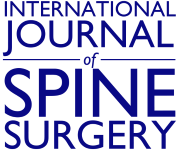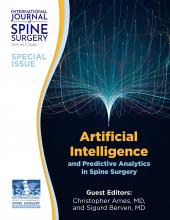Article Figures & Data
Tables
- Table
Summary of future data points to implement in adult spinal deformity assessment for artificial intelligence modeling prediction.
Category Category and Type of Markers Measure Findings or Significance Frailty Serological markers General etabolism Adiponectin Mitochondrial dysfunction Mitochondrial transcription factor A DNA degradation Oxidative stress Malondialdehyde Carbonyl Systemic inflammation C-reactive protein IL-6 TNF-α Clinical tests SPPB Standing balance on both feet, gait speed in a 4-m walk, and chair-stand repeated 5 times Gait speed Total distance/time Timed up-and-go test Rise from a standard armchair, walk to a marker 3 m away, turn, walk back, and sit down again Aging and senescence Serological markers Epigenetic clocks Complex mathematical modeling including DNA methylation and laboratory values that reflect organ function and inflammatory state including albumin,
creatinine, glucose, and C-reactive proteinTelomere length Telomere length is regulated by an enzyme called telomerase, and the degree of shortening is proportional to the risk of common diseases of aging and mortality. -Omics Transcriptomics, proteomics, and metabolomics analysis among other. Complex bioinformatics and advanced computing algorithms are required to perform the analysis of over 10,000 different protein expressions and circulating and excreted metabolites as well as oxidative stress Sarcopenia Radiological MRI/CT Fatty acid infiltration of paravertebral and psoas muscles MRI/ultrasonography Femoral quadriceps area and volume DXA Appendicular lean mass index Clinical tests Muscle grip Grip of dominant hand measured with a dynamometer SPPB Timed up-and-go test Gait speed Body mass index Immunohistological Glycoprotein Dickkopf 3 (Dkk3) Marker of age-related muscle atrophy Pax7 Transcription factor regulating the myogenic potential and function of satellite cells in muscle repair and regeneration, marker of proper cell function Sca-1 and PDGFRα Markers of fibroadipogenic progenitor cells that are readily converted into adipocytes and lead to muscle fatty infiltrates Gross examination Muscle fibers Atrophic muscle fibers have smaller cytoplasmic volumes but intact cellular machinery Degenerated fibers have altered characteristics such as myophagocytosis and cellular infiltration, fiber splitting, and cytoplasmic disruptions. Bone quality Radiological markers CT Hounsfield units; high-resolution peripheral quantitative CT DXA Bone density; trabecular bone score; hip-axis length, hip-strength analysis, and finite element analysis Ultrasound Radiofrequency echographic multispectrometry Serological markers Micro-RNA and long-noncoding RNA, especially miRNA-103a Novel markers and targets for new therapies or interventions Immunohistological Expression levels of runt-related transcription factor 2, osteocalcin, osteoprotegerin, and the receptor activator of nuclear factor kappa-B ligand. Bone remodeling and preservation Abbreviations: CT, computed tomography; DXA, dual-energy x-ray absorptiometry; IL-6, interleukin 6; MRI, magnetic resonance imaging; SPPB, short physical performance battery; TNF-alpha, tumour necrosis factor alpha.







